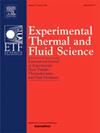Study on the effect of surfactant on the liquid diffusion process based on the liquid-core cylindrical lenses
IF 2.8
2区 工程技术
Q2 ENGINEERING, MECHANICAL
Experimental Thermal and Fluid Science
Pub Date : 2025-06-19
DOI:10.1016/j.expthermflusci.2025.111550
引用次数: 0
Abstract
The liquid diffusion coefficient, reflecting the diffusion rate is an important basic parameter for studying the liquid mass transfer process. Speeding up liquid diffusion rates is of great significance for improving efficiency and reducing costs. However, at present, the commonly used methods mostly require increasing the temperature of the diffusion system, which is not usually applicable to active molecules. This paper proposes a new method to enhance the diffusion rate at room temperature by adding a small amount of an appropriate surfactant to a liquid diffusion system. To verify this method, the diffusion coefficients of ethylene glycol, glycerol, and triethylene glycol diffused in water with and without a surfactant (sodium dodecyl benzene sulfonate), at five different temperatures were accurately measured using the equal-refractive-index thin-layer method based on a liquid-core cylindrical lens. In addition, the diffusion activation energies of alcohols with and without surfactants were calculated using the Arrhenius formula. Results showed that the addition of a surfactant effectively reduced the diffusion activation energy and increased the liquid diffusion coefficient at room temperature. This method of enhancing the diffusion rate without temperature changes can be widely applied in the chemical, medicinal, and biological fields, among others.
基于液芯柱透镜的表面活性剂对液体扩散过程影响的研究
反映扩散速率的液体扩散系数是研究液体传质过程的重要基本参数。加快液体扩散速度对提高效率、降低成本具有重要意义。然而,目前常用的方法大多需要提高扩散系统的温度,这通常不适用于活性分子。本文提出了一种通过在液体扩散体系中加入少量合适的表面活性剂来提高室温扩散速率的新方法。为了验证这一方法,我们使用基于液芯柱透镜的等折射率薄层法精确测量了乙二醇、甘油和三甘醇在有和没有表面活性剂(十二烷基苯磺酸钠)的水中在五种不同温度下的扩散系数。此外,用阿伦尼乌斯公式计算了含表面活性剂和不含表面活性剂的醇的扩散活化能。结果表明,在室温下,表面活性剂的加入有效地降低了扩散活化能,提高了液体扩散系数。这种在不改变温度的情况下提高扩散速率的方法可以广泛应用于化学、医药、生物等领域。
本文章由计算机程序翻译,如有差异,请以英文原文为准。
求助全文
约1分钟内获得全文
求助全文
来源期刊

Experimental Thermal and Fluid Science
工程技术-工程:机械
CiteScore
6.70
自引率
3.10%
发文量
159
审稿时长
34 days
期刊介绍:
Experimental Thermal and Fluid Science provides a forum for research emphasizing experimental work that enhances fundamental understanding of heat transfer, thermodynamics, and fluid mechanics. In addition to the principal areas of research, the journal covers research results in related fields, including combined heat and mass transfer, flows with phase transition, micro- and nano-scale systems, multiphase flow, combustion, radiative transfer, porous media, cryogenics, turbulence, and novel experimental techniques.
 求助内容:
求助内容: 应助结果提醒方式:
应助结果提醒方式:


